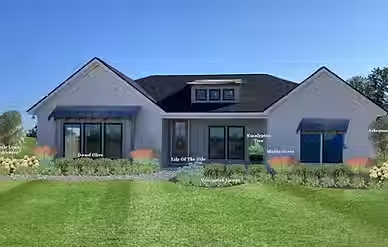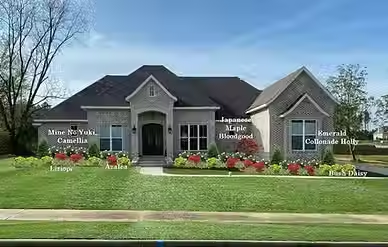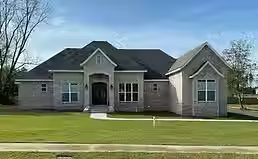
WE PLAN, YOU PLANT
From patios to privacy screens to flower beds, we can create something beautiful just for you!
We know that tackling a landscape project can feel overwhelming, but don’t worry—we make it easy. Whether you need a little inspiration or a full design plan, we’ve got you covered. And if planting feels like too much, we can even connect you with someone to do the hard work for you!
With years of experience in landscape design, we love bringing ideas to life—big or small. Every yard has its challenges, but that’s where we shine. Let’s turn those challenges into something amazing together!
Give us a call, set up an appointment, or just scroll down to get started. We can’t wait to help!
Before and After Photos

What should I expect?
Once you send us electronic pictures of the area you want to be landscaped we will design your landscape with our design program.
You will end up with:
-
A picture of exactly what your finished landscape will look like.
-
A scheduled walk-through presentation of the design at the nursery with the designer or knowledgeable staff member.
-
A cost estimate for plants and planting material
How do I get started?
To get started, you will need to purchase a $500 store credit and fill out the questionnaire before we begin the design process. This gift card can be used to purchase the plants from the design or anything else sold at Dothan Nurseries.
-
How do I change the color of my hydrangeas?To Make Hydrangeas Blue: Lower the soil pH by adding aluminum sulfate and using acidic mulch. To Make Hydrangeas Pink: Raise the soil pH by adding lime and avoiding aluminum. Remember not all hydrangeas change colors, only mophead and shade hydrangeas change color with a PH change.
-
How often should I water my trees or shrubs?It depends on when it was planted and the time of year.
-
What kind of plant(s) can I use for neighbor defense?We love the Green Giant Arborvitae and the Sweet Viburnum. Both are evergreen and fast-growing to help give you privacy quickly and year-round.
-
When should I prune my roses?The Rose Society recommends pruning roses back on February 14th, yup Valentine's Day! It’s an easy-to-remember date. But the wonderful thing about roses is you’re able to really prune them back anytime and they just flush out more beautifully after!
-
When is a good, fast-growing shade tree for this area?The Drake Elm, River Birch, and the Summer Red Maple. If planted, watered, and fertilized properly they can grow 3-6 feet a year.
-
Can I plant my citrus in the yard?We do not recommend planting lemon, lime, grapefruit, or orange citrus in your yard. Even though we are in the south it gets too cold here to plant them in the ground. You can plant satsuma and cumquats in the ground without having to worry too much about them.
-
What is the best time to plant trees and shrubs?In the South, you can plant anytime. Planting in late spring or summer requires daily watering while planting in late winter, early spring, or fall needs less frequent watering.
-
When is the best time to fertilize my trees and shrubs?We recommend fertilizing in the spring to avoid promoting new growth too early, which could freeze. This timing encourages healthy growth for the growing and fruiting season. However, our year-release fertilizer can be applied anytime.
-
When do I cut back my Crape Myrtle tree?We like to cut them back in late February or early March. This way spring is just around the corner, and they will start to push out new growth within a few weeks.
-
What is the brown/black spots on my roses, hydrangeas, and Japanese magnolias?Is caused by a fungus, common in our humid climate. To prevent this, spray them with fungicide once a month during spring and summer.
-
When should I prune my (azaleas, camellias, hydrangeas, etc.)Hydrangeas: Prune based on type—late winter or early spring for those that bloom on new wood; after flowering for those that bloom on old wood. Azaleas: Prune right after they bloom, in late spring or early summer. Camellias: Prune after blooming, in late winter to early spring. Proper timing helps ensure healthy growth and a good bloom cycle for these plants.
-
What are chill hours?Chill hours refer to the amount of time fruit trees need to be exposed to cold temperatures, typically between 32°F and 45°F (0°C to 7°C), during their dormant period (fall and winter). This cold exposure is essential for many fruit trees to break dormancy and trigger proper flowering and fruit production in the spring. Different fruit tree varieties have specific chill hour requirements, and planting a tree in a region where it won't receive enough chill hours can lead to poor fruit development. Common fruits that need chill hours include apples, peaches, plums, and pears. We only carry fruiting trees that have a minimum number of chill hours.
-
What are some low-maintenance evergreen shrubs?Indian Hawthorne, dwarf yaupon holly, boxwoods, pittosporum, dwarf podocarpus, oleander, dwarf procumbens nana, vintage jade distylium, dwarf olive,
-
What is a perennial?Plants that live for multiple growing seasons
-
Do perennials die back?Yes, they will die back when it gets cold and start growing back out in the spring
-
What does it mean to deadhead?Removing the dead blooms from plants to encourage new blooms
-
What are some drought-tolerant annuals?Zinnia, Lantana, Portulaca, Marigolds, Sunflowers, & Vinca
-
Can annuals and perennials be planted together?Absolutely! We love putting them together!
-
What are some drought-tolerant perennials?Lavender, Rosemary, Salvia, Gaillardia, Russian sage, Coreopsis, Sedum, Agapanthus, & Yarrow.
-
How can I attract pollinators to my garden?Simply plant pollinators attracting plants in your garden, it’s that easy!
-
What is an annual?Plants that typically only grow for 1 growing season, usually about 6 months.
-
Can annuals and perennials grow in containers and in the ground?Yes, they absolutely can!
-
What plants are toxic to dogs and cats?Many common plants are toxic to dogs and cats. We recommend referring to the ASPCA website for a full detailed list. https://www.aspca.org/pet-care/animal-poison-control/toxic-and-non-toxic-plants
-
What soil is best for my raised garden bed?An airy soil with nutrients. We have a bulk garden bed soil that works great it is 50% aged bark, 20% Compost, 20% peat moss, and 10% sand.
-
What pests do I have and how do I treat them?Got pests on your plants? Bring or send us a picture, and we’ll identify the problem and solution.
-
What is considered full sun or partial sun/shade?In southern Alabama, "full sun" refers to any sunlight after noon. "Full shade" means no direct sunlight. "Part shade" is when there's no sun after 11 a.m., while "part sun" indicates sunlight up until noon.
-
Should I water in the morning or the evening?Morning is the best time to water, as plants, like us, drink throughout the day, especially in hot weather. Watering in the morning helps them stay hydrated. In the humid Southeast, watering at night can encourage fungal issues, which are already common in the area.
-
Is a sprinkler system good for watering my newly planted plants?Using a sprinkler system is not recommended for newly planted items. Most systems are designed to water lawns, reaching only about 3 inches deep. New plants need deeper watering to reach their roots, so sprinklers usually don't provide enough water to keep them healthy.
-
Can I plant in the summer months?Yes, you just must be very diligent with watering daily.
-
When should I fertilize my plants and what should I use?We recommend our specially formulated fertilizers. Our granular fertilizer for trees, shrubs, and perennials is applied once a year, while the Dothan Nurseries Houseplant granular food provides a 4-month release.
-
What do those numbers mean on the fertilizer?1st number- Nitrogen - leaf growth & color. 2nd number - Phosphorus - roots, fruit & flowers, & 3rd number Potassium – roots, stems, overall plant health, and how it handles stress & disease.
-
What do yellow leaves mean?Typically, too much water or the water isn’t draining well enough.
-
Do you offer a warranty on your plants?Yes, we offer a 3-month warranty on our trees, shrubs, and perennials. Additionally, we provide a 3-year warranty if you purchase our recommended chicken compost soil conditioner and specially formulated year-release fertilizer.
-
How often/much/long should I be watering?The watering schedule depends on the time of year. We recommend hand-watering newly planted items with a gentle stream for a full minute per plant. From October to April, water once or twice a week, adjusting for temperature—more if it's a warmer winter, less if colder. From May through September, daily watering is preferred for new plants.
-
What does it mean when a plant needs a pollinator?When a plant needs cross-pollination, it requires pollen from another plant of the same species to produce seeds, unlike self-pollination where it uses its own pollen. Pollinators like bees, butterflies, birds, bats, wind, or water help transfer this pollen.
-
Do you do landscaping?We don't offer landscaping services, but we have a trusted list of landscapers we've worked with for years.
-
When is the best time to plant?In the South, you can plant anytime. However, if planting in late spring or summer, you'll need to water daily. Planting in late winter, early spring, or fall requires less frequent watering.
-
What is the hardiness zone and what zone are we?Hardiness zone refers to the temperature highs and lows that plants can handle outside. Since 2024 Southeast Alabama is 9A.
-
What weed killer do I use and how do I use it?Choose a weed killer based on the type of weed: grassy or broadleaf. We offer products for both types. Shop Here
-
When should I be using pre-emergent?It’s best to use it once in the fall, once in the winter, and once in the spring or summer.
-
I have trouble growing grass under the trees in my yard, what kind should I be planting?You’re going to want to put down a shade tolerant sod, St. Augustine & Zoysia are the best shade-accepting grasses. No grass loves shade, but these will tolerate it best, we can’t promise great results in shade.
-
What is pre-emergent?Pre-emergent is a product we recommend using on your lawn throughout the year. It prevents the weed seeds from germinating helping break the weed cycle.
-
Can you tell me what this weed is in my yard?We typically can’t tell you what kind of weed it is, but we can tell you how to get rid of it! Come and see us!
-
Do you plant the plants?No, we’ll provide the plan, and you get to do the fun part—planting your plants! We can also give you a list of three or four great local landscapers that we recommend that would be happy to install your landscape for you!
-
Do I get an overhead design plan?We can do an overhead-type landscape design once we are finished with your picture design for a fee of $200. This is not a $200 store credit, but a $200 fee for the overhead design.
-
What will I recieve?You will end up with a picture of exactly what your finished landscape will look like. A scheduled walk-through presentation of the design at the nursery with the designer or knowledgeable staff member A cost estimate for plants and planting material
-
How much does this cost?You will need to purchase a $500 store credit before we begin the design process. This gift card can be used to purchase the plants from the design or anything else sold at Dothan Nurseries.
-
What is the turn around time?Depending on the time of year and the complexity of the project, the design process can last anywhere from 2-4 weeks.
-
What if I want to get more than one space done?We can only design one area of your yard at a time. If you want multiple areas of your yard designed, you will need to purchase an additional $500 store credit. So please only send in pictures of one area of your yard. If you want 2 or more areas designed, please go through this process again, purchasing another $500 store credit for each section.
-
How many revisions do I get?Once you receive your first draft of your plan, we will make up to two revisions. Revisions are defined as any change to the first draft of your plan.
-
About once a week the leaves at the bottom of my houseplants turn yellow. Why does this happen?This is typically a sign of overwatering. Remember most houseplants like to dry out in between watering.
-
What houseplants can I put in a room with zero natural light?ZZ plants & Sansevierias work great in this type of situation
-
What type of soil should I use?We use and recommend the Fox Farm Ocean Forest it has great drainage and plenty of nutrients. We also have our own blend of carnivorous plant food that we recommend for bug-eating plants.
-
Why is my plant leaning all in one direction?Plants follow the sun, so they will lean to try to get to the sun. You can simply turn your plant when you water and it will start to grow to the other side.
-
How often should I water my houseplants?It depends on what type of house plant you have. Some require less water and some more water. Plants that like less water would be plants like Sansevierias, ZZ Plants, Cacti, Succulents, and Chinese Evergreens. Most other houseplants like to be watered every 7-10 days. Be sure to let them dry out in between waterings, this helps their roots grow. However, you have some things that do like to stay moist like most of the fern family.
-
How often should I repot?How do I know when my plant needs to be up-potted? Most plants enjoy being root-bound. Once they are completely root-bound and start to display signs of being unhappy that is when we recommend you up-pot them, only increasing the pot size by a couple of inches at most.
-
Should I top or bottom water?This is a completely personal preference.
-
Why is water dripping off my houseplants?It is the plant's way to remove excess water, they also do this to help cool its leaves and the air surrounding them, much like human sweat.
-
Why is my cactus/succulent becoming thin and lanky?They need more sun; they are stretching for the sun and with that, they get thin and lanky. Do the lights in my home give my house plants nutrients/energy? Wouldn’t that be helpful? Sadly, no, they do not. You can get LED or fluorescent grow lights that will give them the proper type of light. My houseplants keep dying, am I watering too much? Always make sure you have a well-draining pot for starters. As for the water, It could be too much water or not enough. The best way for us to help you is for you to send us pictures through any of our socials or our cell phone at 334.674.1451
-
Why do my houseplants have small bugs flying around them? What are they? How do I fix it?Those are fungus gnats. Pesky little things. The first thing we tell people is fungus gnats show up when you keep your soil too moist, letting your plants dry out in between watering will help this situation. What are the best houseplants to get started with? How do I choose the right houseplant? What type of watering schedule would you like to have with your new plants? Are you going to want to water a lot or forget about them and hardly water them? Depending on that information we can direct you to the best plants for you to start with.
WANTING TO GIVE A UNIQUE GIFT?
How about a We Plan, You Plant Landscape Plan!!!
If you would like to purchase a $500.00 Gift Card for a Landscape Plan without filling out the questionnaire please click the button below. We have a great list of local landscapers we recommend to plant the plants for you.
**Reminder, The questionnaire & photos will need to be completed for us to start the We Plan, You Plant Landscape Plan.






